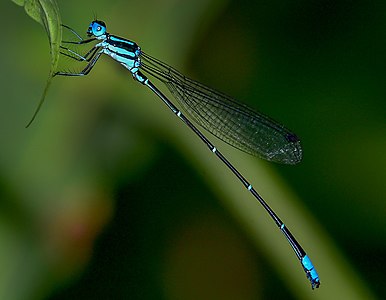Esme longistyla
Esme longistyla[2][1] is damselfly in the family Platycnemididae. It is commonly known as the Nilgiri bambootail.[3] It is endemic to Western Ghats in India.[1][4]
| Esme longistyla | |
|---|---|
 | |
| Male | |
| Scientific classification | |
| Kingdom: | |
| Phylum: | |
| Class: | |
| Order: | |
| Family: | |
| Genus: | |
| Species: | E. longistyla |
| Binomial name | |
| Esme longistyla Fraser, 1931 | |
Description
It is medium sized damselfly with about abdomen 42–44 millimetres (1.7–1.7 in) and hindwings about 28–29 millimetres (1.1–1.1 in) with black-capped blue eyes. Its thorax is velvet-black on dorsum and azure blue on sides. The dorsum is marked with narrow ante-humeral blue stripes. There is another moderately broad black stripe over the postero-lateral suture. The base of the sides are pale blue. The under side of the thorax is greenish yellow or blue. The legs of the males are black. The abdomen is long and slender. The first and 8–10 segments on the abdomen are azure blue. The second segment of the damselfly is black with board irregular azure blue stripes on sides of abdomen. The segments from 3–7 are black with azure blue rings at the end of each segment. The segments 8 to 10 are azure blue; but the sides of segment 10 and apical border are narrowly black. Anal appendages are black. Females are similar to males; but more robustly build.[5][6][7][3][8]
It is considerably smaller than Esme cyaneovittata and Esme mudiensis, the only two other known species of the genus in Western Ghats. It differs from E. cyaneovittata by the shape of the anal appendages, the anterior lobe of the prothorax being wholly blue and the hind pair of legs marked with blue. It can be distinguished from E. mudiensis by the labrum blue, bordered with black.[5]
Habitat
The species is found perching on overhanging vegetation over torrential forest streams. It breeds in forest streams.[5]
See also
- List of odonates of India
- List of odonata of Kerala
References
- Kakkasery, F. (2011). "Esme longistyla". IUCN Red List of Threatened Species. 2011: e.T175164A7116038.
- Martin Schorr; Dennis Paulson. "World Odonata List". University of Puget Sound. Retrieved 12 October 2018.
- "Esme longistyla Fraser, 1931". India Biodiversity Portal. Retrieved 12 March 2017.
- K.A., Subramanian; K.G., Emiliyamma; R., Babu; C., Radhakrishnan; S.S., Talmale (2018). Atlas of Odonata (Insecta) of the Western Ghats, India. Zoological Survey of India. pp. 114–115. ISBN 9788181714954.
- C FC Lt. Fraser (1933). The Fauna of British India, including Ceylon and Burma, Odonata Vol. I. Red Lion Court, Fleet Street, London: Taylor and Francis. pp. 266-268.
- C FC Lt. Fraser (1931). Additions to the Survey of the Odonate (Dragonfly) Fauna of Western India, with Descriptions of Nine New Species (PDF). pp. 471–472.
- Subramanian, K. A. (2005). Dragonflies and Damselflies of Peninsular India - A Field Guide.
- "Esme longistyla Fraser, 1931". Odonata of India, v. 1.00. Indian Foundation for Butterflies. Retrieved 12 March 2017.
External links
![]()
![]()
